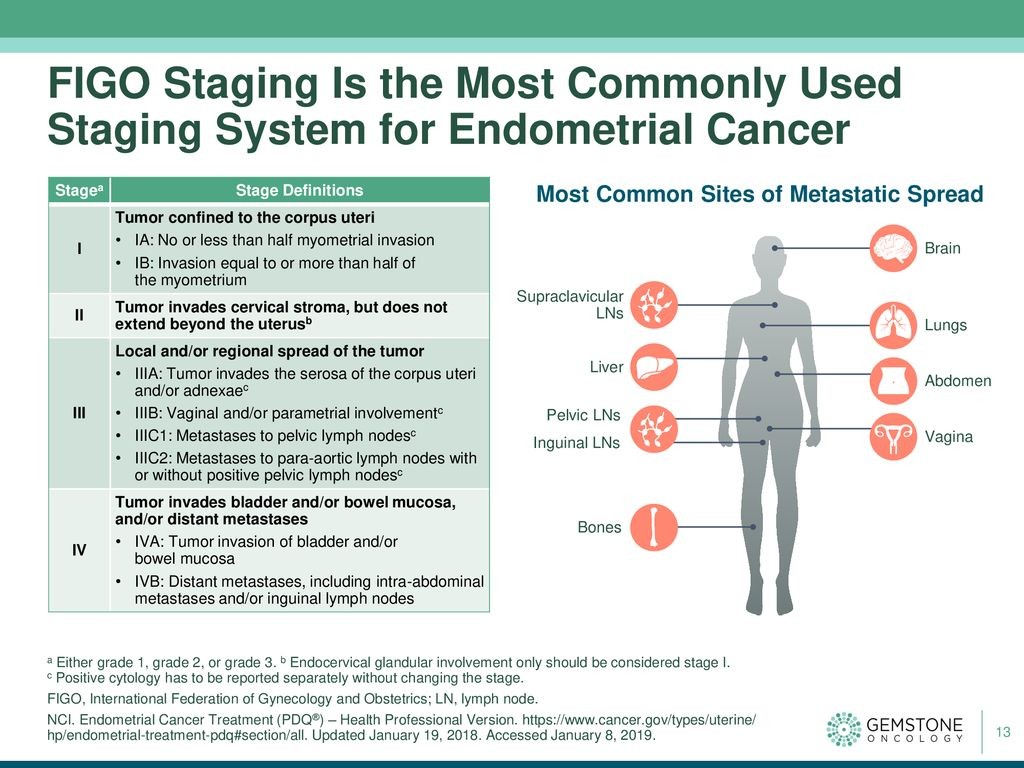
Contents
How Serious Is Endometrial Cancer?
Endometrial cancer is the most common malignancy of the female reproductive organs. It begins in the endometrium—a tissue layer that surrounds the uterus’s interior.
Endometrial cancer has a peak incidence between the ages of 65 and 74 years. There are no standard screening tests for this cancer, and some women may be unaware of the symptoms and warning signs until a later stage of the malignancy.
In the United States, endometrial cancer has increasing incidence and mortality rates.
- Approximately 47,000 cases are diagnosed in the United States each year, resulting in approximately 8,000 deaths.
- The seriousness of endometrial cancer risk is associated with the stage of the disease. Nearly 80 percent of cases are diagnosed in women aged 55 years or older; however, the number of younger women with endometrial cancer continues to rise yearly.
According to the National Cancer Institute’s Surveillance, Epidemiology, and End Results Program, 65,950 women in the United States are expected to be diagnosed with endometrial cancer in 2022, and nearly 12,550 women may die from this disease.
Although endometrial cancer is the most common gynecologic cancer, it is typically treatable. The five-year survival rate is nearly 82 percent, and most women survive if the cancer is detected early.
What are the stages of endometrial cancer?
Oncologists use staging to describe where endometrial cancer is diagnosed and how far it has progressed. Once the stage of endometrial cancer is confirmed, your doctor can recommend a treatment plan. According to the International Federation of Gynecology and Obstetrics (FIGO) system, there are four stages of endometrial cancer, which are further divided into substages.
Four stages of endometrial cancer according to the FIGO system include:
- Stage I
- The tumor is developing inside the uterus and glands surrounding the cervix but not in the supporting connective tissue of the cervix.
- Cancer has not migrated to neighboring lymph nodes or distant places.
- It can be divided into stages IA and IB.
- Stage IA: The tumor has spread from the endometrium to the myometrium (the muscular outer layer of the uterus). However, it has not migrated to neighboring lymph nodes or distant places.
- Stage IB: The tumor has progressed from the endometrium to the myometrium but has not moved outside the uterus. There is no evidence of metastasis into neighboring lymph nodes or distant regions.
- Stage II
- Cancer has progressed to the supporting connective tissue of the cervix. However, it has not spread to the uterus, adjacent lymph nodes, or other distant locations.
- Stage III
- The cancer spreads outside the uterus but not to the rectum, urinary bladder, lymph nodes, or distant organs.
- Can be further divided into stages IIIA, IIIB, and IIIC.
- IIIA: Cancer has progressed to the serosa (outer surface of the uterus) and/or to the adnexa (fallopian tubes or ovaries). However, cancer has not spread to lymph nodes or distant organs.
- IIIB: Cancer has progressed to the parametrium (vaginal or uterine tissues) but not to lymph nodes or distant locations.
- IIIBC: Can be further divided into stages IIIC1 and IIIC2.
- IIIC1: Cancer is spreading throughout the uterine cavity. It has progressed to some surrounding tissues but not into the bladder or rectum, and it has migrated to pelvic lymph nodes but not to lymph nodes around the aorta or distant organs.
- IIIC2: Cancer is spreading throughout the uterine cavity. It has progressed to specific neighboring tissues but may not have spread into the bladder or rectum. It has also migrated to lymph nodes around the aorta (para-aortic lymph nodes) but not into distant organs.
- Stage IV: Can be further divided into stages IVA and IVB.
- Stage IVA: Cancer has progressed to the rectum or inner lining of the urinary bladder. It may or may not have migrated to adjacent lymph nodes.
- Stage IVB: Cancer has spread to lymph nodes in the groin, the upper abdomen, the omentum, or organs beyond the uterus, such as the lungs, liver, or bones. Cancer can be of any size and has the potential to spread to additional lymph nodes.
The primary site is the location where cancer begins. Cancer can spread from its initial location to other parts of the body. It is essential to recognize that even if endometrial cancer is diagnosed in other parts of your body, it is considered endometrial cancer metastasis.
What are the treatment options for endometrial cancer?
Treatment of endometrial cancer may depend on the stage, age, and underlying health condition of the person with endometrial cancer.
Treatment options for endometrial cancer
- Surgery
- It is the most common and first-line treatment of endometrial cancer, in which tumors and some healthy tissue surrounding them are removed.
- Most often-used surgical treatment for endometrial cancer. The surgeon will conduct a basic or radical hysterectomy depending on the extent of the malignancy.
- The uterus and cervix are removed with a basic hysterectomy, whereas the cervix, uterus, upper section of the vagina, and adjacent tissues are removed during a radical hysterectomy.
- The surgeon can remove lymph nodes surrounding the tumor during a hysterectomy to detect whether cancer has spread beyond the uterus.
- This can be accomplished by lymph node biopsy or lymphadenectomy, which involves the removal of a set of lymph nodes.
- Uses X-rays to eliminate malignant cells.
- Can be administered either externally (where radiation is directed toward cancer and surrounding tissue) or internally (when radioactive material is inserted in thin tubes and implanted near the cancer cells).
- Typically comprises a set of treatments administered over a period.
- They are often used following surgery to clear any leftover cancer cells. It is sometimes administered before surgery to shrink the tumor.
- If surgery is not an option for certain women, radiation treatment is indicated. For some women, radiation treatment is the best option for preventing cancer recurrence.
- Slows the development of some types of uterine cells. It generally entails taking a large dosage of the sex hormone progesterone as a tablet.
- Helps shrink some tumors or reduce symptoms. It can also be used in conjunction with other treatments by women who are unable to undergo surgery or radiation therapy.
- The drug is given to regulate and alleviate symptoms of cancer. It generally consists of a set number of cycles during a defined period.
- Chemotherapy aims to kill tumors that remain after surgery, decrease cancerous growth, and limit tumor development if it recurs.
- Also known as biological treatment and is meant to bolster the body’s natural defenses in the battle against cancer. It uses materials to improve immune system function.
- A treatment in which specific genes, proteins, or tissues that contribute to cancer development and survival are targeted. This therapy inhibits the growth of malignant cells while protecting healthy cells.
- Doctors conduct tests to determine the genes, proteins, and other variables in the tumor to better match each person to an appropriate treatment.
- Participating in a research study may be the best treatment option for some individuals. Clinical trials are conducted to determine whether novel cancer therapies are safe and effective or better than the usual treatment.
- Some clinical trials only enroll participants who have not previously received treatments. Other studies look at treatments for people whose cancer has not improved.
- Clinical studies also look for novel strategies to prevent cancer from recurring or reduce the adverse effects of cancer treatment. Discuss with your doctor about various clinical trials near your place.
Treatment options depend on the stages
- Stage I endometrial cancer
- Surgery
- Radiation or chemotherapy
- Hormone therapy, may be given to those who have additional medical problems, which don’t allow surgery
- Surgery
- Radiation therapy
- Chemotherapy, may be given to some
- Surgery
- Chemotherapy
- Radiation therapy
- Tumor biomarker testing, can aid in the decision-making process for targeted therapy, immunotherapy, and other clinical trials
Eating well and being active after endometrial cancer treatment are crucial to your recovery. It boosts your health and well-being while lowering your risk of diseases like heart disease and diabetes. Maintaining a healthy weight, eating properly, and having an active lifestyle may even reduce your risk of additional malignancies.
What Is Polycythemia Vera?
What are the survival rates for endometrial cancer?
Doctors often use survival rates to show the outlook (prognosis) of individuals with endometrial cancer. The five-year survival rate is the percentage of people who live for at least a half-decade after being diagnosed with endometrial cancer.
Survival rates for endometrial cancer depend on the stage
| 90 percent |
| 88 percent |
| 75 percent |
| 69 percent |
| 58 percent |
| 50 percent |
| 47 percent |
| 17 percent |
| 15 percent |
Many individuals with endometrial cancer live longer than this period and others recover completely. Although some succumb to cancer, others die from secondary causes. These rates do not apply to cancer cases that have recurred after treatment or spread after treatment has begun.


